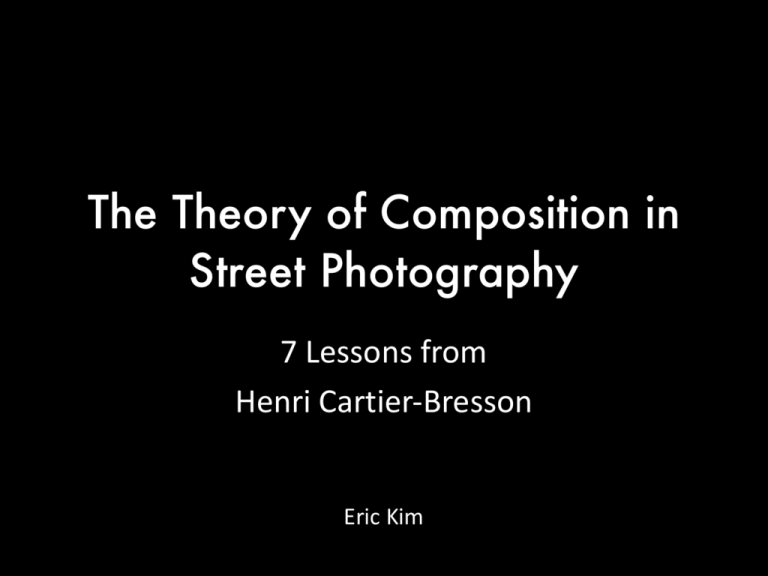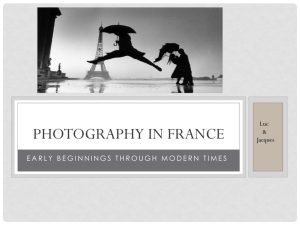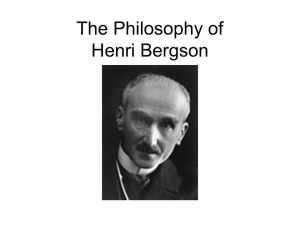advertisement

The Theory of Composition in Street Photography 7 Lessons from Henri Cartier-­‐Bresson Eric Kim 1. Organize reality • “To take photographs means to recognize– simultaneously and within a fraction of a second– both the fact itself and the rigorous organization of visually perceived forms that give it meaning.” -­‐ Henri Cartier-­‐Bresson 2 3 Henri Cartier Bresson / SPAIN. Andalucia. Seville. 1933. 4 Henri Cartier Bresson / ITALY. Friouli. Trieste. 1933. 2. Communicate the subject • “If a photograph is to communicate its subject in all its intensity, the relationship of form must be rigorously established. Photography implies the recognition of a rhythm in the world of real things. What the eye does is to find and focus on the particular subject within the mass of reality; what the camera does is simply to register upon film the decision made by the eye.” -­‐ Henri Cartier-­‐Bresson 5 6 Henri Cartier Bresson / GREECE. Cyclades. Island of Siphnos. 1961. Henri Carier-­‐Bresson : G.B. 1937. England. London. Hyde Park in the grey drizzle. 3. Focus on “slight modifications” • “The photographer’s eye is perpetually evaluating. A photographer can bring coincidence of line simply by moving his head a fraction of a millimeter. He can modify perspectives by a slight bending of the knees. By placing the camera closer to or farther from the subject, he draws a detail– and it can be subordinated, or he can be tyrannized by it. But he composes a picture in very nearly the same amount of time it takes to click the shutter, at the speed of a reflex action.” -­‐ Henri Cartier-­‐Bresson 11 Henri Cartier-­‐Bresson FRANCE. 1932. Marseille. The Allée du Prado. 4. Trace your photos after • “Later, to substantiate this, you can take a print of this picture, trace it on the geometric figures which come up under analysis, and you’ll observe that, if the shutter was released at the decisive moment, you have instinctively fixed a geometric pattern without which the photograph would have been both formless and lifeless.” -­‐ Henri Cartier-­‐Bresson 14 The “Golden Triangle” Henri Cartier-­‐Bresson: ROMANIA. 1975. In a train. Henri Cartier-­‐Bresson : 1967. Martine's Legs. 5. Follow your intuition • “Composition must be one of our constant preoccupations, but at the moment of shooting it can stem only from our intuition, for we are out to capture the fugitive moment, and all the interrelationships involved are on the move.” -­‐ Henri Cartier-­‐Bresson 24 25 Henri Cartier Bresson / SPAIN. Madrid. 1933. 26 Henri Cartier Bresson / JAPAN, Tokyo 1965 6. Analyze your photos afterwards • “In applying the Golden Rule, the only pair of compasses at the photographer’s disposal is his own pair of eyes. Any geometrical analysis, any reducing of the picture to a schema, can be done only (because of its very nature) after the photograph has been taken, developed, and printed– and then it can be used only for a post-­‐mortem examination of the picture. I hope we will never see the day when photo shops sell little schema grills to clamp onto our viewfinders; and the Golden Rule will never be found etched on our ground glass.” -­‐ Henri Cartier-­‐Bresson 27 Fibonacci Spiral 28 Fibonacci Spiral + Golden Triangle 29 30 31 32 33 34 35 36 7. Don’t crop • “If you start cutting or cropping a good photograph, it means death to the geometrically correct interplay of proportions. Besides, it very rarely happens that a photograph which was feebly composed can be saved by reconstruction of its composition under the darkroom’s enlarger; the integrity of vision is no longer there. There is a lot of talk about camera angles; but the only valid angles in existence are the angles of the geometry of composition and not the ones fabricated by the photographer who falls flat on his stomach or performs other antics to procure his effects.” -­‐ Henri Cartier-­‐Bresson 37 38 Henri Cartier Bresson / SPAIN. Valencia. 1933. 39 40 Learn More About Composition • • • • • • • • • • • • • • Composition Lesson #1: Triangles Composition Lesson #2: Figure-­‐to-­‐ground Composition Lesson #3: Diagonals Composition Lesson #4: Leading Lines Composition Lesson #5: Depth Composition Lesson #6: Framing Composition Lesson #7: Perspective Composition Lesson #8: Curves Composition Lesson #9: Self-­‐Portraits Composition Lesson #10: Urban Landscapes Composition Lesson #11: "Spot the not" Composition Lesson #12: Color Theory Composition Lesson #13: Multiple-­‐Subjects Composition Lesson #14: Square Format 41







